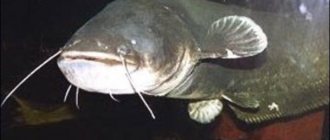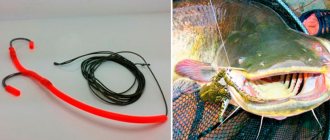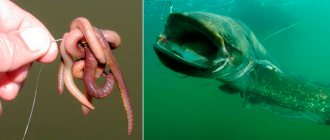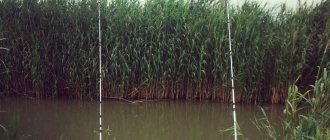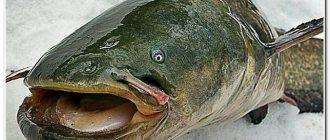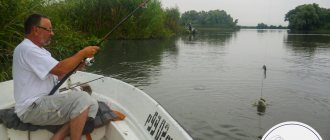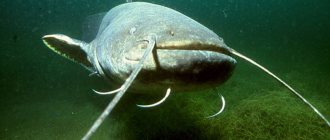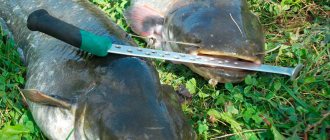Catfish is a large predator that lives in fresh water reservoirs. Of the permanent river inhabitants, it has no equal in size and weight. Its weight can reach 400 kg and its length can be 3 meters.
| Class | Fish |
| Squad | Catfish |
| Family | Catfish |
| Genus | Soma |
| View | Common catfish, sea catfish also live in Europe |
| Security status | The number of fish has decreased, and in many reservoirs it needs protection. In Karelia it has been listed in the Red Book since 1995 as a rare species. |
| The average size | Weight – 55 kg, length – 1 m |
| Lifespan | 80 years old |
| What does it eat? | The main diet is fish, but can eat almost anything, even dead animals |
| Optimal feeding time | They go hunting at night |
| Enemies | Human |
| What do they bite on? | Live bait weighing from 100 g, shell meat |
How big does catfish grow?
According to historical data, the common catfish is capable of growing to gigantic sizes: information was recorded about a trophy that weighed more than 400 kg and was 5 m long.
Currently, due to increased fish catches, specimens weighing more than 100 kg are considered very rare. The largest catfish are found in deep, well-warmed rivers with sufficient food and places for shelter.
You can determine the approximate weight of a trophy by its size. To do this, the fish is measured from the top of the snout to the end of the longest blade of the caudal fin.
The ratio of length and weight of catfish is given in the table:
| Catfish length , cm | Maximum weight of catfish , kg |
| 30 | 0,4 |
| 60 | 1,8 |
| 90 | 5 |
| 110 | 10,5 |
| 130 | 17 |
| 150 | 26,5 |
| 170 | 35 |
| 200 | 64 |
| 250 | 110 |
How much does the largest catfish weigh?
A huge catfish weighing just under 300 kg was caught in Thailand on the Mekong River. Today this giant is considered the largest in the world.
The same catfish
How do catfish reproduce?
For the first time, male and female catfish go to spawn at 4-5 years of age. Reproduction of catfish begins after the water warms up to the optimal +16-18 degrees. Depending on weather conditions, the beginning of spawning falls in mid-May to early June.
You can determine when and where catfish spawn by strong splashes of water: before the start of spawning, the males perform a kind of dance to please the female. From several males, she selects one for herself and goes with him to a secluded place in shallow water. Usually the female lays eggs in thickets of reeds or algae, in depressions covered with snags or large stones. In a place chosen by the couple, the male, using fins and a snout, prepares a small hole for the eggs.
The fertility of a female depends on her size: on average, there are about 30 thousand eggs for every kilogram of weight. After spawning is completed, the female returns to her usual habitat, and the male remains near the nest. He protects the eggs from other inhabitants of the reservoir until the larvae appear (this happens on days 8-10) and remains nearby for another week, looking after the young. The male leaves the nest after the fry, which have increased in size, swim away from the nest in search of shelter.
Where does catfish live?
The catfish spends most of its life at the bottom of the reservoir, choosing areas with a soft, silt-covered bottom. The traditional habitat of fish is holes and depressions in places where there is a difference in depth, littered with submerged logs and snags, or overgrown with algae. The catfish carefully selects shelter and makes a hole there, in which it can remain throughout its life, leaving it only for the breeding and wintering periods.
Typically, adult individuals settle alone, but if there is a lack of secluded places, several males and females of the same age and size can live in one hole.
Catfish are not found in dirty water. Often, after prolonged rains and floods, they are forced to abandon their inhabited holes and look for backwaters with clean water.
Chain catfish
In the photo - Amazonian fish Pseudorinelepis genibarbis
, which the Peruvians call carachama sin costilla, which means “catfish without ribs” - they actually have no ribs below the sixth vertebra.
Karacham in the Amazon are called representatives of the chain catfish family (Loricariidae). This is a large (more than 90 genera) family from the order Catfish, distributed almost everywhere in the tropics and subtropics of South and Central America. Chainmail catfish are completely covered with thick armor made of bone plates, spiny and almost impenetrable. In their armor, they are similar to another South American family of catfish - armored catfish ( Callichthyidae
).
Catch from armored karacham. Photo © Sergey Moshkovsky, Loreto, Peru, November 2021
Chain catfish are very numerous in the Amazon and live in rivers, oxbow lakes and lakes, preferring places rich in rotting wood and all sorts of decaying organic matter. With their suction cup mouth (it is visible just to the left of center in the first photo and, if you look closely, in the third), they, like sandpaper, scrape off layers of rotten wood and algae and at the same time suck in insects and other invertebrates that live in it. Since there is little oxygen in such reservoirs, Karachams are able to “breathe” air by swallowing it, and in the dry season they move to where there is more water. Many chain-mailed catfish dig holes in the banks of rivers and lakes, in which they hide from predators and spawn. During the dry season, when the water level drops sharply, Amazonian rivers and lakes expose clay banks, dug with Karacham burrows.
The belly of the Karacham is the most unprotected place; here the armor is thinnest. Photo © Sergey Moshkovsky, Loreto, Peru, November 2021
Like armored catfish, many species of armored catfish are popular among aquarists. But the inhabitants of the Peruvian Amazon (and their guests represented by the author of this text) do not value them for this. Karacham makes a wonderful soup! The soup is called chilcano (or timbuche) de carachama and requires some skill to prepare it. The catfish are first stunned by hitting the “back of the head” with a machete: Karachams easily tolerate a lack of oxygen and, if they are not stunned, can jump and fight in the basin for a very long time without any water. Then the karachi is gutted, opening the belly, which is not covered with such thick plates as the rest of the body. Whole armored fish are thrown into the soup, adding garlic, seasonings and always a herb called “long coriander” - eryngium foetidum
) from the Umbelliferae family, a bit like cilantro. They eat karacham like crayfish, picking the meat out of the shell.
Karachama five minutes before entering the soup. Photo © Sofya Dolotovskaya, Loreto, Peru, November 2021
Small chain-mail catfish live in small rivers, and in larger rivers live serious Karachams that inspire respect among all Peruvians. They are called karachama mama and reach a meter in length. The Quechua word "mama" means "mother" and also "chief" or "first" (the thumb is also mama). A lake in Quechua, for example, is called kucha, and a sea or ocean is called mama kucha. From the Quechua language the word passed into the Spanish language of Peru and neighboring countries, and it is used to designate everything large and important: cuchara - spoon, mama cuchara - large spoon. Karachamama are several particularly large species of chain catfish, for example Acanthicus adonis
or
Acanthicus hystrix
. Unlike small catfish, which are often caught simply by hand in drying up reservoirs, karacham mam are caught in nets. And, of course, they also make a wonderful soup.
Photo © Sergey Moshkovsky, Loreto, Peru, November 2021.
For life in the Amazon jungle, see also:
1) Devil’s Garden, “Elements”, 02/14/2018. 2) “Chronicles of the Amazon”, blog of Sofia Dolotovskaya on N+1.
Sofia Dolotovskaya
What do catfish eat?
Catfish is a predatory fish. It traditionally goes out hunting after dark, sets up an ambush and attacks passing fish. Catfish teeth are small but sharp. This makes it possible to hold the caught prey well, which it swallows whole. If the size of the prey does not allow this, the catfish waits for it to die and begin to decompose, and then eats it in parts.
The diet of the predator varies depending on the growth stage. In the first months of life, the fry eat zooplankton, insect larvae, small crustaceans and mollusks. Young individuals eat eggs and fry of other inhabitants of the reservoir, small amphibians, crayfish, and shrimp. Adults attack birds and small mammals caught in the water.
What else does catfish eat? It is known that in nature, plant and organic waste can become food for giants. By eating dying vegetation, dead fish and animals, catfish help clean up water bodies.
How to catch catfish
The period of active catfish biting begins immediately after waking up, approximately a month before spawning. After a short break, the predator’s activity resumes. All summer the catfish hunts regularly, gaining mass for winter. It leaves for wintering grounds early: already at the end of September-beginning of October, predators that have fattened up over the summer burrow into the silt and stop feeding.
The best time to fish for catfish is from sunset to early morning. For fishing, use a spinning rod or a bottom fishing rod with a hard and durable rod. Fishing lines and hooks are selected depending on the weight of the intended trophy and taking into account the fact that when caught, the predator offers energetic and strong resistance. It can be attracted by gear that creates an imitation of movement: silicone baits, wobblers, spoons.
You can use live bait as bait: small fish, amphibians, a bunch of worms, pieces of meat or offal. To attract predators to the fishing site, the following baits are used:
- chopped pork or beef skin;
- a mixture of ground intestines, lard and offal;
- ready-made mixtures with the addition of fish oil.
When a catfish bites, it feels like the hook is caught on something flexible or elastic. It is necessary to give the fish the opportunity to grab the bait deeper and then hook it. It is quite difficult to pull out a large and strong catfish: having felt the tackle, it actively resists and tries to hide in snags or other shelter. There is no need to rush to pull the predator to the shore; it must be sufficiently tired. If you get caught on tree roots or snags, you should periodically tug the line. This will help lure the catfish out of a secluded place.
If the fish is pulled in by hand, you must make sure that the line does not wrap around your fingers or wrists: at the moment of the next jerk of the predator, it can get caught and seriously injure you.
How does catfish fishing work?
Fishing for catfish is quite in demand, if only simply because even a small catfish is already a solid catch. But, of course, to take possession of this fish you need special skills.
Even a fisherman who does not have much experience behind him can catch catfish, but for this he needs to have special information. Everyone knows that for a successful result and achieving a goal, experience is necessary, and this case is no exception.
Before you start fishing, you need to get ahead of the catfish habitats.
Typically, such places are holes, bends and turns of rivers, and depressions in reservoirs. But even under such conditions, fishing for catfish will not become problematic, because it can be reproduced from the shore.
Read here Bream - description of the fish, fish habits, feeding features, choice of bait and fishing gear (105 photos and videos)«>
Fans of fishing for this fish should understand that the catfish never leaves its favorite places, except in rare cases. While in its nest, the catfish waits for prey.
On warm nights, you can watch catfish frolicking on the water and indicating their location with splashes.
This can also be observed during a thunderstorm. This is a big plus for fishermen, because with the help of such tricks you can easily determine the favorite habitats of catfish.
It is worth clearly knowing that where the catfish emerges, there is a hole. The next step is to throw the bait exactly into the area where the fish previously surfaced. In this case, the probability of success is quite high.
Features of cooking catfish
Catfish meat is juicy, tender and fatty. The minimal content of connective tissue simplifies the process of digestion. The calorie content of fillet is 115 kcal per 100 g. White meat of a predator is considered a valuable product: it contains essential amino acids, vitamins (A, B, PP, C), microelements (calcium, iodine, iron, zinc, phosphorus, fluorine).
When cutting and preparing fish, you need to consider the following:
- young, medium-sized specimens have more tender meat without any foreign taste; adult fish develop a characteristic river smell;
- the catfish skeleton does not contain small bones;
- You can remove the unpleasant taste from large catfish by soaking portioned pieces of fillet in milk for 3-4 hours;
- fat in the body of a catfish is distributed unevenly, most of it is in the tail;
- The carcass should be stored frozen, so the fat contained in the meat will not go rancid.
Catfish in cooking is used to prepare fish soup, aspic, it is stewed, baked, fried, and used as a filling for rolls and pies. Catfish meat, with its high fat content, is excellent for barbecuing and smoking.
Catfish in cooking
Catfish is very useful for losing weight. Meat contains substances and elements that speed up metabolism. This characteristic has a beneficial effect on the process of losing weight.
The burning of extra pounds occurs due to easy digestion and rapid digestibility of the pulp. But fried meat in oil or fat can cause harm. To eat fish while losing weight, you need to steam it, simply boil it, make soup, and salads.
When choosing a recipe, it is worth considering some features. There is no need to use large individuals. They have tough flesh, and the swampy smell is almost impossible to remove.
The meat is fatty, but it contains few calories. Fish cooked in a double boiler is indicated for patients with diabetes and people diagnosed with obesity. Catfish meat contains little connective tissue, so it is easily digested and very healthy for children.
The product is also necessary for athletes and people who have calcium deficiency. The pulp has a positive effect on the skeletal system, prevents brittleness and hair loss, and strengthens the legs.
There are many options for preparing catfish dishes. Many recipes require little time and ingredients, and the results are beyond praise. They like to bake the river inhabitant in the oven with vegetables - potatoes, zucchini, cabbage, carrots. It is important not to overcook the food in the oven so that it does not become dry. Experts recommend not removing the skin when baking, so the catfish will not lose its juiciness.
You can also get delicious meat if you bake it over a fire. If you pre-marinate it, you will get a tasty, juicy kebab or steak. What cooking options are there:
- in a slow cooker with gravy, sour cream;
- in the oven with vegetables and other seafood;
- in a steamer with rice, green beans;
- Fry in a frying pan and make cutlets.
Minced catfish makes tender, healthy and nutritious dishes. You can use it to make cutlets, meatballs in sauce, potato pancakes with meat filling, and rolls. The pulp is also used in cooking soups: kharcho, fish soup, cabbage soup, and solyanka.
To fight off the characteristic smell of mud, you need to familiarize yourself with some tips that will help remove the unpleasant odor:
- First you need to cut the fish, wash it and cut it into pieces or steaks.
- The finished pulp is poured with a small amount of lemon juice or dry white wine. Let it brew for 20 minutes.
- The pieces are washed under running water. Next, they are immersed in milk and allowed to stand for 2-3 hours.
The second option is to clean the catfish and cut it into the necessary pieces. Then they are covered with salt and left for 1 hour in the refrigerator. Next, wash in water with acetic acid.

